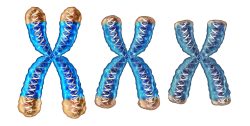 Telomeres, which are located at the ends of chromosomes, play a crucial role in protecting DNA from deterioration. The enzyme telomerase helps preserve the length and structural integrity of telomeres, thereby regulating the aging process. Recent studies have identified a novel small molecule that can replenish telomerase levels and reverse signs of aging in senior mice. In preclinical models, significant reductions in aging indicators and symptoms were achieved.
Telomeres, which are located at the ends of chromosomes, play a crucial role in protecting DNA from deterioration. The enzyme telomerase helps preserve the length and structural integrity of telomeres, thereby regulating the aging process. Recent studies have identified a novel small molecule that can replenish telomerase levels and reverse signs of aging in senior mice. In preclinical models, significant reductions in aging indicators and symptoms were achieved.
Telomerase reverse transcriptase (TERT) is a critical protein component of telomerase. As people age, the gene responsible for producing TERT tends to deactivate, resulting in lower levels of active telomerase in the body. Numerous laboratories have been working on developing treatments that can reactivate the TERT gene. Sustaining TERT levels in older lab models has shown to lessen cellular aging and inflammation, promote the generation of new neurons enhancing memory, and improve neuromuscular function, thereby boosting strength and coordination.
In recent research, scientists have identified a molecule, referred to as the TERT activator compound (TAC), that achieves this reactivation. They have discovered that activating the TERT gene extends telomeres in cells of tissues that grow and increase rapidly. Additionally, they found that this gene activation improved aging signs in cells that had not produced telomeres, indicating that TERT also plays a role in regulating aging-related genes beyond its conventional function in telomere maintenance.
Mice treated with TAC exhibited numerous anti-aging benefits compared to the control group mice. These included decreased cellular aging and neuritis, along with an increased production of new neurons in the hippocampus. Elderly mice, which began receiving TAC injections at about 20 months of age, which would be equivalent to a senior adult, showed enhanced cognitive performance after 6 months. Additionally, one test revealed improved grip strength in these mice, indicating that the compound also boosted muscle function.
The study emphasizes the considerable potential for regenerating aging organ systems and the possibility of therapeutically adjusting indicators of aging in the natural aging process. These initial findings are promising due to TAC’s effective absorption across various tissues, including the brain. Nonetheless, further investigations are crucial to fully determine its safety and efficacy in prolonged treatment scenarios.
To view the original scientific study click below:
TERT activation targets DNA methylation and multiple aging hallmarks





